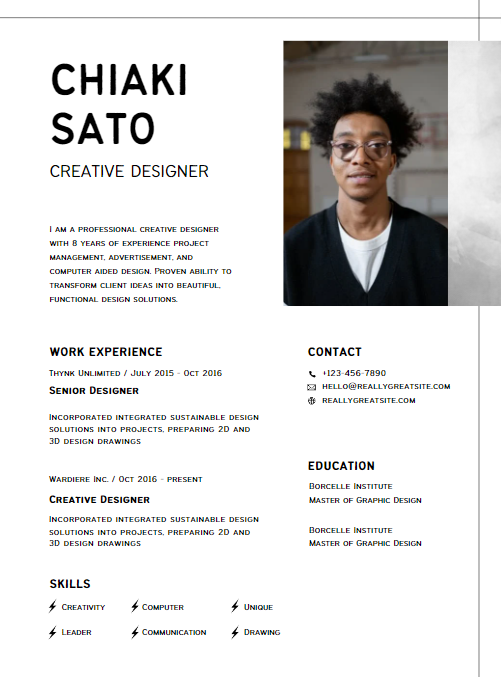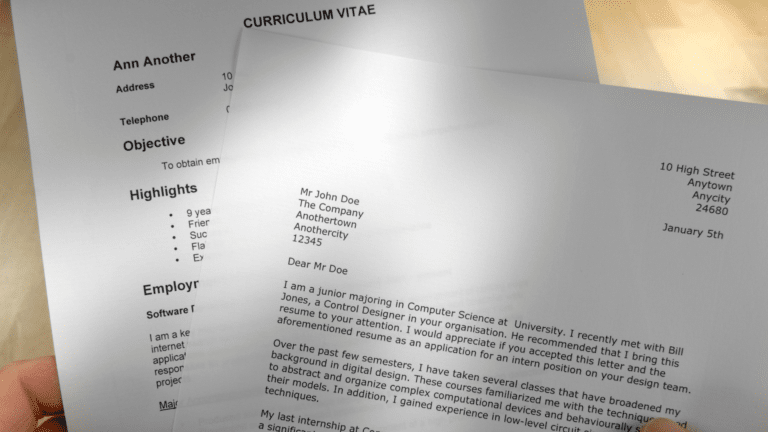Since you’re currently in the job market, you’ve likely come across CV vs. resume confusion. And truth be told, it can get tricky to pinpoint the key differences between the two.
While both documents summarize your work experience and qualifications, they serve different purposes in the job market.
You can think of your CV as your life story—a detailed account of your education, accomplishments, and publications. On the other hand, your resume is a highlight reel. It shows your skills and relevant experience for a specific job.
So, if you don’t know when to use a CV vs. a resume, keep reading to find out!
Key Takeaways
- When we talk about CV vs. resume, they are two different types of documents used for job applications, that mostly differ in format and content.
- A CV is a detailed document that includes information about education, research and publications. It’s typically used in Europe and Asia.
- A resume is a document that highlights skills, achievements, and work experience. It is more commonly used in the US and Canada.
- Regardless of which format you choose, the number one priority is to tailor the document to the job application.
- Some of the most distinguishable elements of a CV can include publications, presentations, awards and honors.
- On the other hand, key elements of a resume can include volunteer work, certifications, licenses, and achievements.
What is a CV?
A CV (or curriculum vitae) is a detailed document that outlines one’s education, work experience, skills, achievements, and other relevant information. Unlike a resume, which is typically 1-2 pages long and more tailored to a specific job application, a CV is a comprehensive document that can be several pages long.
CVs are commonly used in academic, scientific, medical, and research fields, and they’re most common in European and African countries. In these fields and regions, CVs are the preferred format for job applications, grant proposals, and academic positions.
The European countries that prefer CVs are the United Kingdom, Ireland, and France, whereas in Africa, it is most commonly used in South Africa.
A CV should highlight relevant experience and qualifications, and it should also include detailed information on your publications, presentations, and awards, which are especially important in academic and research fields.
It’s also a good idea to use keywords from the job posting to help your CV stand out to potential employers.
What is included in a CV?
Here is a list of what a CV should include:
- Personal information. Your name, address, phone number, email address, and other relevant contact information should be included at the top of your CV.
- Personal statement or objective. A brief statement that summarizes your experience and qualifications and highlights your career goals.
- Education. This section should include information about your degrees, including the institution’s name, degree earned, and any relevant coursework.
- Work experience. A detailed account of your previous work experience which should include job titles, duties, achievements, and the time of employment.
- Skills. A list of relevant job skills that you possess, such as language or interpersonal skills.
- Publications. A list of any articles, books, or other publications that you wrote or co-wrote.
- Presentations. Any conference presentations or public speaking engagements that you have participated in.
- Awards. A detailed list of awards, honors, scholarships or any academic achievements.
- Professional memberships. This is optional, but it can be helpful to include professional organizations or societies that you belong to, as some of them can be quite selective, and this also shows dedication to the profession.
- References. A list of professional references (such as previous employers) who can attest to your skills, experience, and personality (also optional).
What Is a Resume?
A resume is a concise (1-2 page) document that summarizes your work experience, education, skills, and achievements. It is typically used in the US, Canada, and other English-speaking countries as the preferred format for job applications.
Resumes are tailored to the specific job being applied for and highlight your relevant experience and qualifications. Unlike a CV, a resume focuses on your most recent work experience and does not typically include detailed information about your academic background or research experience.
When creating a resume, it’s important to use a clear and concise format that is easy to read. That’s because a well-crafted resume can help you, as a job seeker, stand out to potential employers, which can then increase your chances of landing an interview.
What is Included in a Resume?
Here’s everything your resume should include:
- Contact information. Your name, email, phone number, and address, so that the employer can contact you.
- Summary or objective. A brief statement of your experience and qualifications, or one that outlines your career goals.
- Work experience. Detailed description of your previous work experience.
- Education. This section should list your degree, and the institution that you attended.
- Skills. Located at the bottom of the resume, the skills section should include your proficiency in specific industry related skills, including technical skills, like SEO, or soft skills, like people or time management.
- Achievements. A list of any job related achievements or accomplishments you’ve earned in your career.
- Certifications or licenses. You can list any certifications or licenses that are related to the job description or industry to strengthen your qualifications.
- Volunteer experience. This is an optional section, however it can still be valuable if there’s any relevant volunteer work you’ve done.
CV vs. Resume: The Main Differences
Here are some of the key distinctions regarding the CV vs. resume debate in different regions:
| Curriculum Vitae (CV) | Resume | |
|---|---|---|
| United States | Can be used for job applications in most industries, but it’s most common in academia and science. | Preferred format for job applications in most industries. |
| Europe | Used for all types of job applications. | Similar to a CV, but may be more concise and tailored to the specific job being applied for. |
| Asia | May include more personal information and a more detailed professional and educational background. | Similar to a CV, but may be more concise and tailored to the specific job being applied for. |
In general, a CV is more comprehensive and includes more detailed information about your academic background, research experience, and even publications, and it’s more commonly used in Europe.
A resume is more focused on your most recent and relevant experience and job skills. It is also the preferred format in the US and Canada.
In Asia, the distinction between a CV and a resume may be less clear, and the document used can be a combination of both, with more personal information and even a photo included. However, it’s still important to tailor the document to the specific job you’re applying for.
Final Thoughts
Whether you’re preparing a CV or a resume, it’s important to understand their key differences and tailor your document to the job you want to apply for.
Whatever format you choose, make sure to showcase your best qualities and use keywords related to the job ad. And if appropriate and especially asked for, don’t forget to include your references.
We hope that you’ve now got your CV vs. resume knowledge in the bag. All that’s left now is to make a good impression on those recruiters and get hired. You’ve got this!












